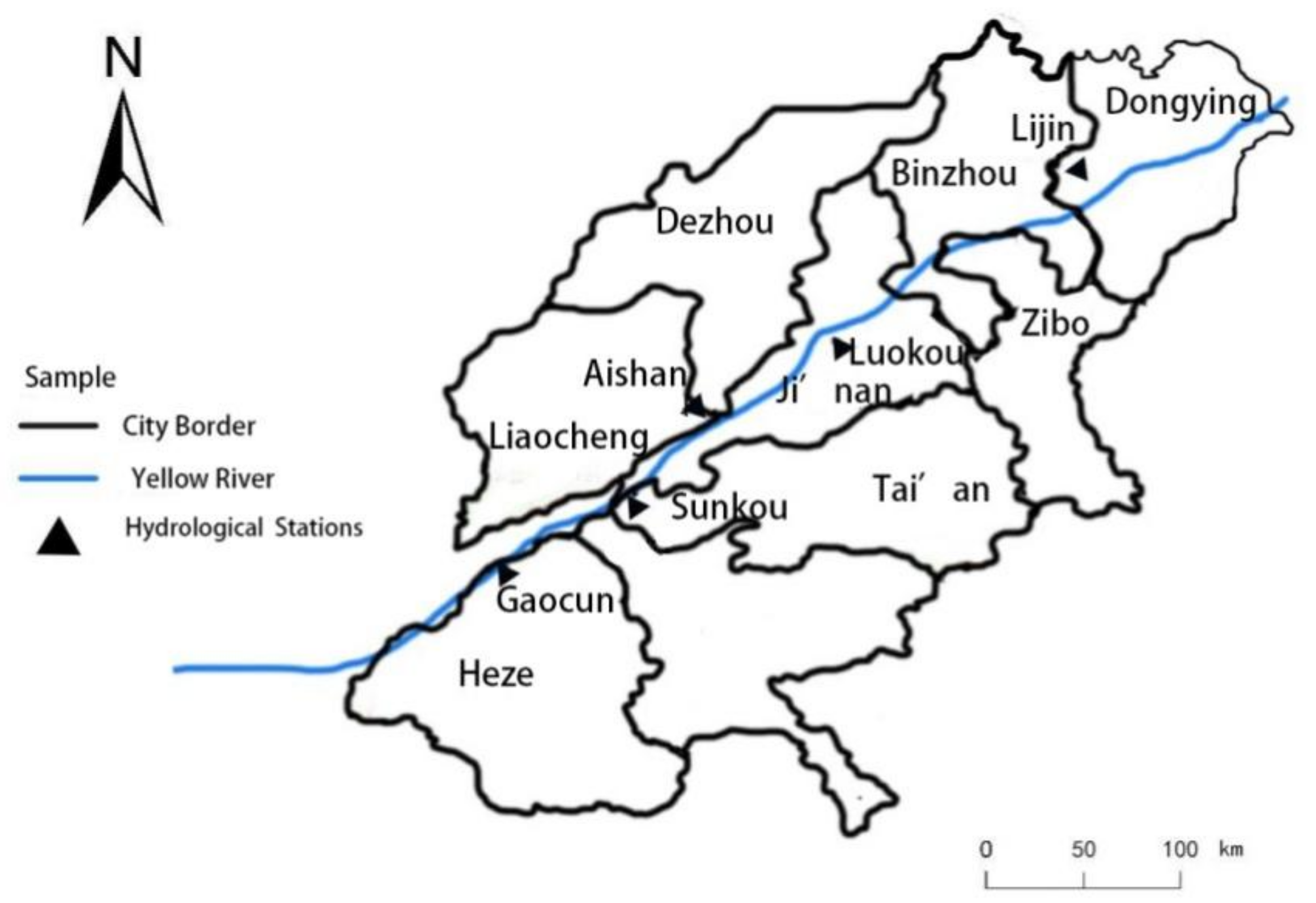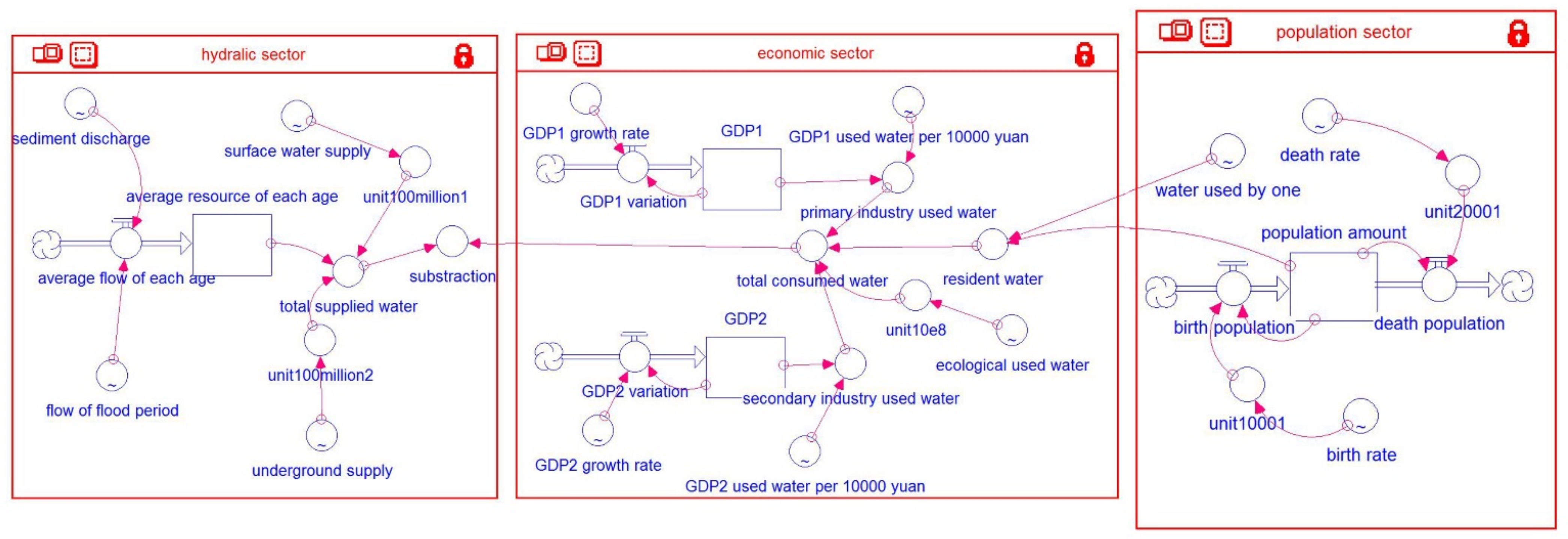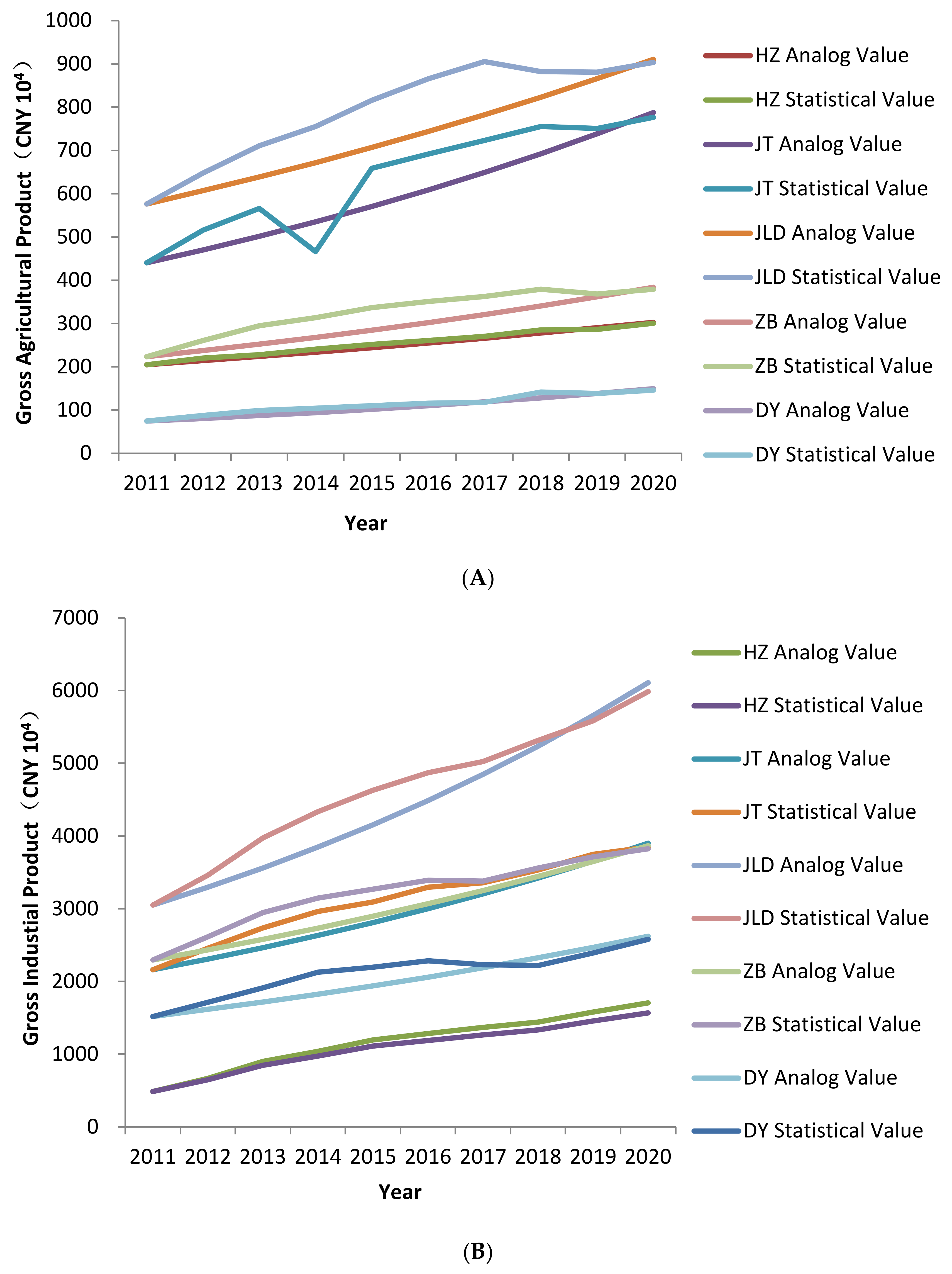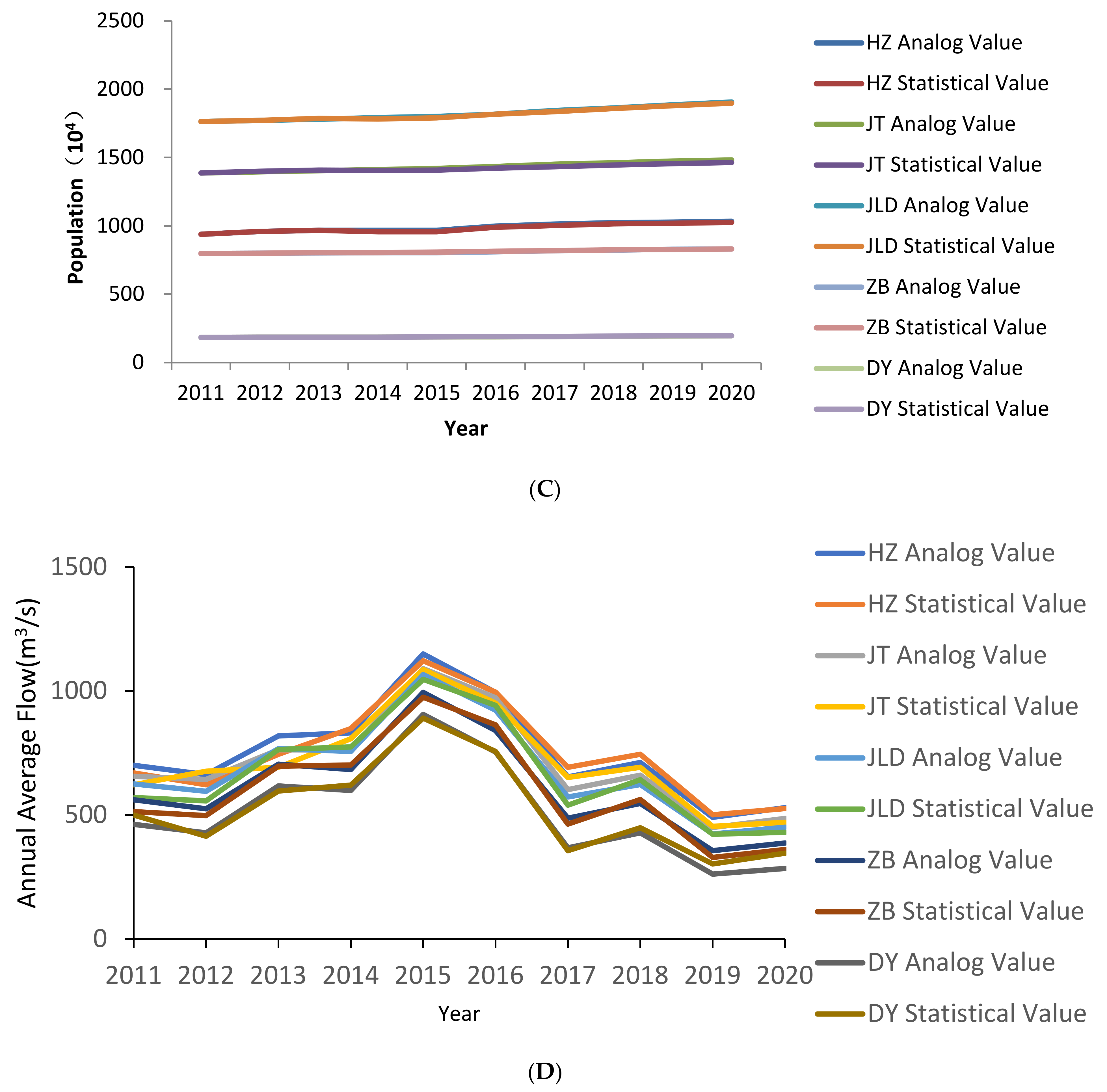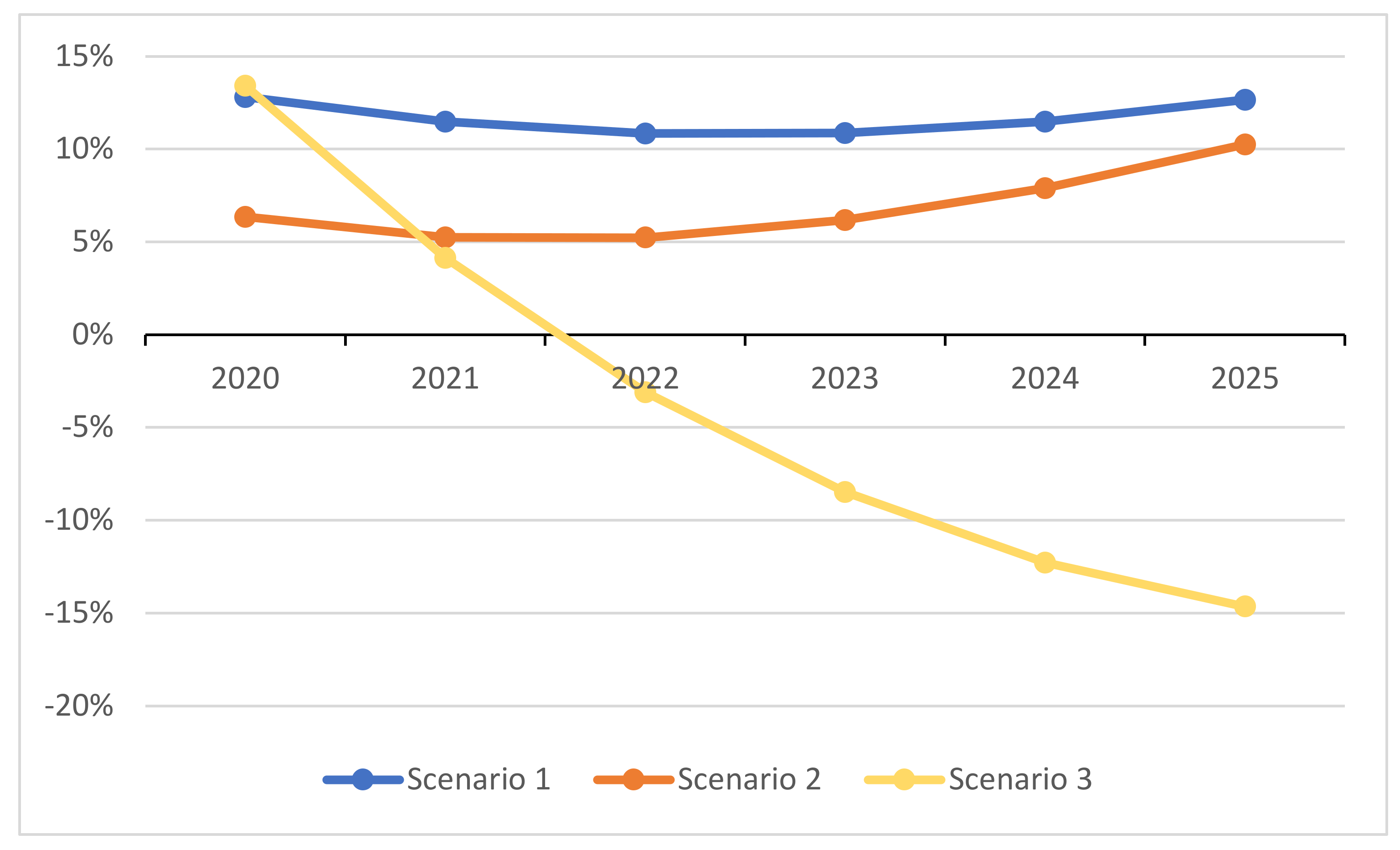1. Introduction
Serving as an ecological barrier and economic zone, the Yellow River basin plays an important role in China. At the forum for the ecological protection and high-quality development of the Yellow River basin, President Xi pointed out: “Protecting the Yellow River is a grand plan for the great rejuvenation and sustainable development of the Chinese nation.” [
1]. The Yellow River basin has an important part to play in winning the battle of pollution prevention and control, playing a very important role in China’s economic and social development and ecological security. High-quality development requires higher standards to maintain the sustainable development of water resources in the Yellow River basin. However, due to limited natural resources and carrying capacity, the Yellow River basin has been facing problems of a fragile ecological environment and severe water resource security. Specifically, the development and utilization of water resources in the Yellow River is unreasonable. The unbalanced distribution of water resources in various regions leads to insufficient water supply in some regions. With the rapid growth of the population accompanied by industries and agriculture that need a lot of water resources, the contradiction between supply and consumption of water resources has increasingly intensified, being difficult to solve and seriously hindering the development of social economy. In addition, the traditional irrigation backward tool results in the waste of water resources, which makes it difficult to use water resources effectively. The supply of the irrigation area is greater than the demand, although the downstream irrigation area is in urgent need of water resources. Coupled with natural and management factors, the waste of water resources in the Yellow River irrigation area is exacerbated.
To realize the sustainability of water resources, many scholars have conducted in-depth research on water resource utilization, water resource ecological protection, ecological footprint, and so on.
In terms of water resources, Dawadi used system dynamics to study the sustainable development of water resources. Combined with water conservation measures and water pricing, the impact of population growth and climate change on water volume in the Las Vegas Valley was studied [
2]. Sušnik also established a system dynamics model to study the potential impact of water scarcity and socioeconomic policies on complex hydrological systems in the Kairouan region [
3]. Yue Yusu constructed a system dynamics model for the beach area in the lower reaches of the Yellow River. He depicted the linkage relationship between water resource management, land resource allocation, and economic and social development of the beach area, and analyzed the impact of different magnitudes of floods on the economic and social system development of the beach area. In order to explore the operation law and change the trend of water resource supply and demand in Shiyan City [
4], Huo Lei designed simulation schemes for water resource development and utilization under three scenarios based on the principles of system dynamics, and taking economic growth, population growth, and water supply sources into consideration to predict the future of the water supply and demand situation [
5]. Qin Huanhuan put forward countermeasures to maintain the sustainable development of social economy and water resources in Longkou City after constructing the relationship between population, industry, agriculture, water resources and water environment [
6]. Zhang Teng researched the supply and demand of water resources in the Haidian District, Beijing City, constructed a system dynamics model illustrating the balance between supply and demand of water resources, and provided countermeasures and suggestions for the development of the Haidian District after full consideration of population, social economy, and water resources [
7].
In terms of ecological protection, Zhang Hongwu focused on the government of the Yellow River estuary and the protection of the wetland in the delta, which is of great significance for the ecological protection of the Yellow River and the high-quality development of social economy [
8]. At the same time, Zhang also believes that it is necessary to consider the reality of the Yellow River basin to achieve benign governance of the lower reaches of the Yellow River [
9]. Hao Fuqin analyzed the impact of the unified water regulation of the Yellow River on the downstream ecological environment from the perspective of the impact of water regulation on the downstream river ecosystem, the impact of downstream water body function, and the impact on wetland in the Yellow River delta [
10].
In terms of ecological footprint, Li Zhongcai used the ecological footprint model to analyze the level of sustainable development of Shandong province from 2011 to 2020. It transpired that the ecological footprint of Shandong province showed a great increase, and the pressure on resources and the environment system gradually accelerated [
11]. Luo Tao researched the supply and occupation of the ecological footprint of the existing flood control projects in the lower Yellow River, quantified the surplus level of ecological footprint, and proposed the guiding contents to optimize project planning, design, and construction and operation [
12].
In terms of ecological water rights, the preliminary solution of the cut-off of the Yellow River is not equal to the realization of the ecological water rights of the Yellow River. Qiu Xiangwei, who believes that the institutional defect of ecological water rights is the fundamental method to solve the erosion of ecological water rights in the lower reaches of the Yellow River, explored the institutional root of the vulnerability of ecological water rights to erosion, and finally put forward several institutional optimization paths to protect ecological water rights [
13].
Based on the above research, it can be concluded that water resources, social population, and economic indicators are the three key elements to determine the sustainability of water resources of the Yellow River, and there is a certain correlation between the three. However, at present, existing domestic research on this correlation is limited. It is necessary to quantitatively consider the systematic relationship of mutual influence and feedback among economy, society and policy factors that affect water demand, so as to capture the systematic behavior of water resource supply and demand. The system dynamics technique is used as a decision tool for engineering problems. It is one of the object-oriented approaches for studying and managing complex feedback systems [
14].
The objective of this article is to provide reference to alleviate the shortage of water resources and to optimize the allocation of water resources in Shandong. Based on system dynamics, taking the lower reaches of the Yellow River in Shandong province as an example, we construct a model for the sustainable utilization of water resources by joining the perspectives water resources, society, and the economy. This is used to simulate the water resources coupled model of Shandong province from 2011 to 2020 and analyze the fitting degree affecting the water in Shandong province. On this basis, three development scenarios, maintaining the original development model and emphasizing the economic development model and the sustainable development model, are set up to simulate the sustainable situation of water resources in the lower reaches of the Yellow River in Shandong province over the next five years.
4. Scenario Analysis
4.1. Scenario Design
To study the sustainable utilization of water resources, this paper mainly concentrated on water supply and water consumption in the lower Yellow River of Shandong province. According to the results of model simulation from 2011 to 2020, it was proven that the coupled model offered value to the research on the sustainability of water resources of the Yellow River. Given this model, this section sets three scenarios. Three simulation scenarios with different circumstances expected from 2020 to 2025 were set up, as shown in
Table 3, to seek the water shortage in the lower Yellow River in Shandong province in line with the future economic and social development trends. The adjusted amount can be found in
Table 6.
Scenario 1 Basic Type
It is hypothesized that the law of development and the law of water volume change in Shandong province is not significant, and that there is no significant economic growth, which means that it keeps on developing as it is, and the natural population growth rate is taken as 5‰ according to the existing average growth rate in national statistics.
Scenario 2 Economic Development Type
The change mainly focuses on the importance of economic development, followed by the management of the riverbank. It is hypothesized that the agricultural GDP growth rate and industrial GDP growth rate are reduced by 2% and that the natural population growth rate is taken as 5‰.
Scenario 3 Sustainable Development Type
This scenario requires stable economic development, with a 2% increase in agricultural GDP growth rate and industrial GDP growth rate. Due to the improvement of production process and awareness of water conservation, the water consumption of agriculture and industry is set to decrease by 20% in this scenario, and the natural population growth rate is increased to 6‰ in combination with China’s gradually liberalized population policy.
4.2. Analysis and Result
This section combines five researched districts as a single one to conclude water deficiency for the whole of Shandong. The statistical results are mainly analyzed from the perspective of the total water supply and water consumption. The water deficiency rate is the ratio of the difference between water consumption and water supply to the water consumption. The equation of water deficiency rate [
5] is:
Within a limited range (−100%~100%), the closer the value is to 0, the better the balance between water supply and water consumption in the region. When the value is negative, the water supply is greater than the water consumption, indicating that the supply is sufficient [
20].
Firstly, the relevant data of five regions were weighted on average. Secondly, the parameters required in the three scenarios were assigned. In order to calculate the total water supply, the initial values of variables such as average annual surface water volume and average annual underground water volume were input. To calculate the total water consumption, the initial values of variables such as agricultural growth rate and industrial growth rate were input. Then, STELLA was used to run the calculation. Finally, the simulation results of water deficiency rate in Shandong Province were conducted according to Equation (15).
The results of water deficiency rate changes for each scenario are shown in
Figure 4, and the three scenarios were simulated with the STELLA software. The values of population growth rate for the regulating parameter in Scenario 1 were based on the average population growth rate of the last ten years in Shandong statistics. Scenario 2 had a higher requirement based on the industrial and agricultural economy. Scenario 3 was a sustainable optimization in terms of industrial and agricultural water consumption and population growth.
In Scenario 1, as the population continues to grow, the water for domestic use will increase year by year, and the five regions will experience a continuous water shortage in the next five years.
Compared with Scenario 1, the overall water shortage is mitigated in Scenario 2 under the condition of lower water consumption for industrial and agricultural purposes, and the water deficiency rate will decrease noticeably by 2022, and from then on gradually gets out of control. This indicates that economic functions have a minor effect on water resources.
In Scenario 3, although the population increases year by year guided by policies, the average water consumption in industry and agriculture decrease as the level of energy-saving technology is updated. By 2025, the total water consumption in the lower Yellow River in Shandong province will be 3.4 billion cubic meters and the total water supply will be 3.7 billion cubic meters. From 2022 onwards, the water deficiency rate will change to a negative value and the water shortage in Shandong province will be alleviated. The water deficiency rate in the lower Yellow River region decreases the most, reaching 30%. This illustrates that water consumption is the most critical element limiting sustainable development.
5. Conclusions and Discussion
5.1. Conclusions
This paper established a model for the sustainable utilization of water resources comprising water resources, social development, and economic development, based on the lower Yellow River in Shandong province with a system dynamics approach. Taking the data of Shandong province as an example, scenario analysis of water shortage in Shandong province for next five years was conducted and conclusions were found.
Firstly, this paper established a coupled “water–society–economy” system model of the lower Yellow River in Shandong province based on system dynamics using STELLA software. After collecting yearly data of five Shandong regions, it was verified that this coupled system model was available. It provides theoretical support for the study of the sustainable development of water resources.
Secondly, based on the establishment of model, the scenario analysis method was used to simulate sustainable utilization conditions for the next five years in Shandong. It was concluded that the overall water deficiency rate of Scenario 1 was larger than that of Scenario 2, and that of Scenario 2 was larger than that of Scenario 3, according to the scenario analysis. In Scenario 3, water consumption was basically sufficient to meet the water supply from 2022. By 2022, the water shortage in the lower Yellow River area of Shandong province would be improved through integrated regulation. The water deficiency rate of Scenarios 1 and 2 decreased by 2022, but water deficiency would recur by 2025, which needs to be further studied.
Thirdly, combining the main model and research results, reasonable suggestions were offered to avail water resources of Shandong. Integrated regulation of the social factors (natural population growth rate) and economic factors (water consumption of industrial and agricultural output) indicators of the coupled model would help to control the water resources in the lower Yellow River area of Shandong Province to effectively maintain a relatively stable state. This can ensure sufficient water resources in the lower Yellow River of Shandong province until 2025. The regulation of the water resources system should be enhanced in the future, and more attention should be paid to the conservation and reuse of water resources.
Thirdly, based on the main models and research results, reasonable suggestions on the utilization of water resources in Shandong province were offered. A comprehensive regulation of social factors (natural population growth rate) and economic factors (industrial and agricultural water consumption) in the coupled model would be helpful to effectively control water resources in the lower Yellow River region of Shandong Province to maintain a relatively stable state. Before 2025, the water resources in the lower reaches of the Yellow River in Shandong province could be sufficient. In the future, the regulation of water resource systems should be strengthened, and more attention should be paid to the conservation and reuse of water resources.
5.2. Discussion
In order to offer a comprehensive and specific study regarding the lower reaches of the Yellow River in Shandong province, it was necessary to analyze the water shortage of five sub regions, which are H.Z., J.T., J.L.D., Z.B. and L.J. in Shandong. Similarly, the three scenarios mentioned in Chapter 4 were used to simulate the changes of scenarios around the country and calculate the water shortage rate in the next five years under each scenario. Finally, the differences of water resource utilization in the five regions were compared.
Due to the complexity and uncertainty of system dynamics, there are some limitations in this study. At the same time, this paper needs further in-depth research. This model is affected by water resource, economic, and social subsystems. Particularly, water quality and reused water should also be considered. Water quality factors include whether each chemical factor meets the standard, which will directly affect the actual availability of water resources. The amount of reused water can not only affect the actual water demand of each region, but also affect the social awareness of water conservation.
